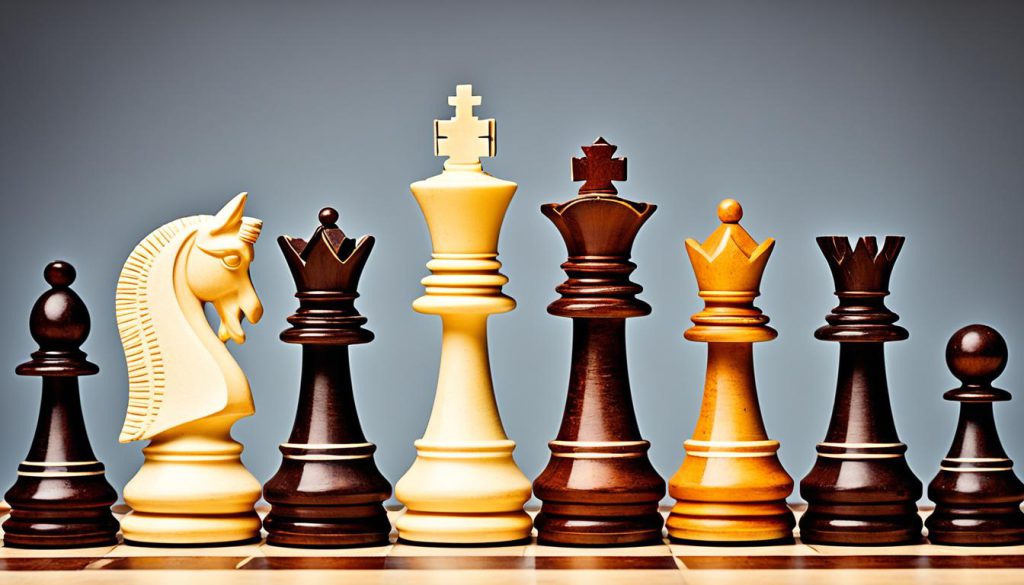“Chess is life.” – Bobby Fischer
Exploring chess’s beginnings takes us on a grand journey through history. It started in the 6th century AD in India, known as “Chaturanga.” This version was the precursor to modern chess, with pieces representing an army’s units, including infantry and elephants. In the 15th century, the introduction of the queen revolutionized the game.
In Europe, chess evolved further around 1200CE. Pawns got new moves. Bishops and queens became more powerful. By the 19th century, European cafes, especially “Cafe de la Regence” in Paris, embraced chess. The London chess tournament of 1851 highlighted this era, introducing the modern era of chess competitions.
Key Takeaways
- Chess originated as Chaturanga in India around the 6th century AD.
- Military-inspired pieces like infantry and elephants were integral to early versions of the game.
- European modifications around 1200CE introduced new movements for pawns, bishops, and queens.
- The transformation of chess in cafes like “Cafe de la Regence” in Paris marked its cultural ascent.
- The London chess tournament of 1851 was a milestone in the history of chess competitions.
Early Beginnings in Ancient India
Chess has a deep history that goes back 1,500 years to Chaturanga in India. This game came about during the Gupta Empire. It showed the main parts of the Indian army like infantry and cavalry.
The Gupta Empire and Chaturanga
Chaturanga means “four divisions of the military” in Sanskrit. It was played on an 8×8 board named ashtāpada. It was more than a game; it taught military strategy and math.
The oldest proof of chess in India goes back to 2450 BC, with clay pieces found in Tamil Nadu. A theory suggests chaturaji, a similar game, may be Chaturanga’s original form.
Migrating to Persia: Shatranj
After leaving the Gupta Empire, chess reached Persia and turned into Shatranj. The Persians loved the game for its strategy and philosophy. “Shatranj” comes from “chaturaṅga,” a Sanskrit word meaning “army.”
In Persia, they added new pieces like the “Queen” instead of the minister. This change showed how the game blended into Persian life. These changes helped shape the chess we know today as it moved to Europe around 1500 CE.
Chess and Its Spread Along Trade Routes
Chess was first known as Chaturanga in ancient India. “4 limbed” refers to the army’s main divisions: infantry, cavalry, chariots, and elephants. It moved beyond India as trade grew.
By 700, Sa’id bin Jubair was famous for playing chess blindfolded. After the Persian Empire fell to the Muslims, chess was allowed by Islamic theologians. These developments helped chess flourish under Islamic rule.
Chinese chess, or xiangqi, came to China around 800, thanks to Buddhist monks from India. Local rules, like in Burma, reflected regional tastes, including unique pawn moves.
Chess reached Japan via Korea, where it became known as Shogi. It arrived in Russia around 820 through trade routes. In 1100, the checkered chessboard was used in Normandy and England for accounting, leading to its modern design.
In 1093, the Eastern Orthodox Church condemned chess. Cardinal Damiani banned clerics from playing it in 1061. Yet, chess was embraced worldwide, shown by the Lewis Chessmen set of Viking origin from 1120. Throughout the Middle Ages in Europe, the game evolved with new rules.
| Timeline | Region/Change | Details |
|---|---|---|
| 7th Century | Persia | Chess became popular under Islamic rule despite initial fears of prohibition. |
| 800 | China | Chinese chess (xiangqi) was introduced by Buddhist travelers from India. |
| 820 | Russia | Spread through the Caspian-Volga trade route. |
| 1100 | England/Normandy | Adopted chessboard for accounting purposes, creating the checkered board. |
| 1120 | Viking Territories | The Lewis Chessmen – Oldest known chess set of Viking origin. |
The story of chess shows its growth through trades and cultures. This set the stage for its global popularity today.
Medieval Chess: Reaching Europe
Medieval chess reached Europe, starting a significant chapter in its history. New rules transformed the game into what we know today. These changes marked an exciting development for chess.
Introduction to Europe
Europe’s introduction to chess is a key chapter in its story. The game spread quickly, first among nobles and then to others. Despite some opposition, chess flourished, enjoyed by royals and analyzed by Leonardo da Vinci.
Rule Refinements in the Middle Ages
In the late Middle Ages, key rule changes shaped chess. Castling, pawn promotion, and the en passant move were added. These made the game deeper and more standardized.
By the 12th century, chess was played widely, with the “bare king” rule common. The first folding chess board was made in 1125, showing chess’s growing popularity and its need for portability.
Chess’s influence grew over the centuries. By the 18th century, it was loved by all social classes. This laid the groundwork for its status as a global phenomenon today.
Read more about the origins of chess and its history here.
The Evolution of Chess Pieces
Exploring the chess pieces evolution shows us the game’s deep history and strategy. The pieces have changed over time, adapting to new ways of playing. This is especially true for the powerful chess queen.

Transformation of Pieces and Their Movements
Originally, chess, known as chaturanga, had six pieces: the King, Minister, War Elephant, Horse, Chariot, and Footsoldier. Each had unique moves, creating early game strategies.
In the 15th century, major changes happened. One big change was the powerful queen’s introduction, making the game more complex. Bishops also got to move diagonally across the board, adding to the game’s depth.
As chess moved to Europe, it went through a cultural and strategic awakening. Iconic sets like St. George and French Regence emerged in the 1800s. The design by Nathaniel Cook in 1849, made by Jaques of London, brought a better set design. Players loved its sturdy pieces and clear piece contrast, marking its place in chess history.
The standardized Staunton sets, now needed for all FIDE tournaments, show this evolution. Kings in these sets are 3.75 to 4 inches tall. Collectible sets from Jaques and Russian designs are highly valued, displaying the game’s rich history and craftsmanship.
| Chess Piece | Original (Chaturanga) | Medieval Transformation |
|---|---|---|
| King | Raja | King |
| Queen | Mantri | Queen (Most Powerful) |
| Bishop | Gajah | Bishop (Extended Reach) |
| Knight | Ashva | Knight |
| Rook | Ratha | Rook |
| Pawn | Padati | Pawn |
The Romantic Era of Chess
The Romantic Era of chess, from the 18th century to the 1880s, loved quick moves more than slow planning. This style shows the beauty in daring chess moves and stunning combos.
Daring Attacks and Bold Sacrifices
This time in chess was bold, with risky moves and big sacrifices. It was known for openings like the King’s Gambit and Giuoco Piano. These led to strong attacks and surprises. A famous game from 1851, the Immortal Game, had Adolf Anderssen make amazing sacrifices.
Rivalries and Key Matches
The Romantic Era was also about great chess battles that excited fans and changed the game. Rivalries like Howard Staunton versus Pierre Charles Fournier de Saint-Amant were huge. They helped make the rules we use today. Stars like Alexander McDonnell, Louis-Charles Mahé de La Bourdonnais, and Paul Morphy became legends with their unforgettable games.
To better understand this era, here is a table comparing key elements:
| Aspect | Romantic Era | Post-Romantic Era |
|---|---|---|
| Period | 18th Century – 1880s | 1880s – Present |
| Style | Aggressive, Tactical | Positional, Strategic |
| Famous Players | Anderssen, Morphy, Zukertort | Steinitz, Lasker, Capablanca |
| Notable Openings | King’s Gambit, Giuoco Piano | Ruy Lopez, Queen’s Gambit |
The Origins of Chess
The origins of chess date back about 1,500 years. It started in India and was known as Chaturanga. By the 6th century, it was popular and showed military strategy with pieces like Boat, Horse, and Elephant.
Chess then moved to Persia, becoming known as Shatranj. It kept its strategic core and philosophical roots. As it traveled along trade routes, it mixed with various cultures. This mix laid the groundwork for its global fame.
In the 16th century, chess began to look as we know it today. The 19th century saw major changes. The chess clock was introduced, and the first book on openings was published in 1843. Chess clocks made the game faster and more competitive.
The first official World Chess Championship was in 1886. Wilhelm Steinitz, the champion, emphasized smart play. The Staunton pattern chess pieces came in the mid-19th century. They helped make the game what it is today.
Famous players like Emanuel Lasker and Jose Raul Capablanca emerged. The Soviet Union was a big player in chess from 1927 to 2006. Champions like Botvinnik, Karpov, and Kasparov made the scene competitive.
Technology also changed chess. In 1997, a computer beat Garry Kasparov. This showed how smart computers can be in chess. Online chess became popular in the mid-1990s. It shows that chess can change and still be loved.
| Milestone | Year |
|---|---|
| Chaturanga Flourished in India | 6th Century |
| Chess Evolved into its Modern Form | 16th Century |
| First Official World Chess Championship | 1886 |
| Kasparov vs IBM Supercomputer | 1997 |
| Popularity of Online Chess | Mid-1990s |
Modern Chess Emerges
The 19th century changed chess in big ways, making it much like it is now. New strategies appeared, and chess became popular worldwide. It was an era of great change for this beloved game.
19th Century Developments
In the 1830s, a big change in chess was the standardized chess sets. Nathaniel Cook made the Staunton design, liked by Howard Staunton. This made games easier to follow and improved chess rules.
That time also gave us the first great chess masters. Chess contests became more popular, leading to the world championships we have today.
First International Chess Tournament (1851)
The first big global chess match was in London, 1851. It was a game-changer. Top players from many places competed. Adolf Anderssen from Germany won, becoming a chess icon. He showed amazing skill, especially in the “Immortal Game.”
This competition showed Anderssen’s talent. It also started a tradition of international chess tournaments. This helped make chess a prestigious game all over the world.
The Soviet Chess School
The Soviet Chess School started a big change in chess. By 1969, it brought to light new strategies and deep chess theories. Mikhail Botvinnik led this era with smart ideas and careful planning.
His impact was huge, highlighted by a famous 1938 game against José Raúl Capablanca. This game showed off the complex strategies of the time.
In the late ’60s, players like David Bronstein brought their own style. By 1968, he was known for his unique approach and Mark Taimanov was also making his mark by 1970. Training and studying game tactics were key aspects of their training.
The foundation created by Mikhail Botvinnik helped future stars like Anatoly Karpov and Garry Kasparov. He is often seen as the founding father of their chess success.
After World War II, the Soviet Chess School gained global recognition. Leaders like Vladimir Lenin saw its value. With players like Botvinnik, the school became famous worldwide.
This success showed how working together and doing detailed study pays off. Every master added something new to chess, helping it evolve further.
The school’s growth brought national pride and stressed the importance of hard work and new strategies. These teachings still impact how chess is taught today.
The Rise of Chess Engines
Chess changed forever with chess engines coming into play. These tools have reshaped how players think and strategize. They offer deep analysis and new strategic ideas.
From Deep Blue to Modern Engines
In 1997, Deep Blue made history by beating world champion Garry Kasparov. This victory showed the world the power of artificial intelligence in chess. It wasn’t just a win; it was a glimpse into the future of strategy games.
Since then, chess engines like Stockfish have grown even stronger. Stockfish can look at millions of positions every minute. It helps players by suggesting the best moves.
Impact on Competitive Chess
Chess engines have changed the game for everyone, from beginners to top players. Engines like AlphaZero use advanced technology to discover new strategies. They show moves people hadn’t thought of before.
The way chess is played in tournaments has evolved. Tactics are more complex, and players are ready for a broader range of moves. This has made chess even more competitive, pushing players to fine-tune their strategies.
| Engine | Year | Significance |
|---|---|---|
| Deep Blue | 1997 | First to defeat a reigning world champion |
| Stockfish | 2011 | Regarded as one of the strongest engines |
| AlphaZero | 2017 | Introduced deep reinforcement learning |
Chess in Popular Culture
Chess has a rich and intriguing history in culture. It evolved from the ancient game of chaturanga before the 600s AD. Now, it’s a strategic art form. By the 16th century, the modern chess game began to take shape. This evolution impacted stories and entertainment greatly. Chess’s role became even clearer with the first official world championship in the late 19th century. Icons like Mikhail Botvinnik have highlighted chess’s influence in popular culture.
The exhibit “Everybody’s Game: Chess in Popular Culture” showcased chess’s broad impact. It ran from October 18, 2012, to April 14, 2013. The exhibit displayed how chess influences gaming, literature, and media. Items like the “Old Crow Limited Edition Ceramic Chessmen” from 1969 were featured.
In gaming, chess’s influence is remarkable. For instance, “Super Mario Bros.” sold 40.24 million copies and incorporates chess-like strategies. Similarly, “The Lord of the Rings” franchise has sold over 150 million copies. It also has a chess set, celebrating its complex story.
The mid-19th century brought major changes to chess. Nathaniel Cooke standardized chess sets, and Howard Staunton endorsed them. These steps helped chess become recognized as a strategic art form. They influenced both high culture and everyday entertainment. Chess stories continued to evolve. For example, the LEGO® Kingdoms Chess Set has 328 plastic pieces. This shows chess’s ongoing charm.
- Chess’s strategic nature enhances drama in literature and movies.
- Chess history, like Philidor’s theories from 1749, has captivated people for ages.
- Exhibits and collections, including ceramic pieces and LEGO® sets, highlight chess’s cultural significance.
Chess storytelling keeps intriguing and challenging us. It showcases the game’s eternal charm through intellectual and dramatic plays. Chess stands as a strong symbol in the heart of popular culture. Its mix of brain challenge and dramatic tension is captivating.
The Digital Age: Chess Online and Streaming
With the digital age, chess has found an exciting new home. Online chess has transformed the way players engage with the game. It connects players worldwide with a simple click. The emergence of streaming chess lets fans watch games live, enjoy expert commentary, and learn strategies as they happen.
Chess on Streaming Platforms
Streaming sites like Twitch and YouTube have greatly impacted the chess world. Champions like GMs Hikaru Nakamura and Magnus Carlsen draw thousands of viewers to their streams. These platforms have made elite chess lessons accessible to all fans. They foster a more dynamic and welcoming chess community through online chess.
Impact of “The Queen’s Gambit”
“The Queen’s Gambit” on Netflix has boosted chess’s popularity. This series shows Beth Harmon’s journey to become a chess master, creating The Queen’s Gambit effect. After its release, chess set sales soared and online chess sites saw a surge in new users. The series captures the game’s beauty and the intense challenge it presents.
Documentaries like “The History Of Chess: The World Chess Championship” also sparked more interest. It explores chess’s rich history over a nine-month study, with unique photos and footage. For instance, it features a rare shot of GM Bobby Fischer. From the first championship in 1886 to the latest battles, such as GM Magnus Carlsen versus GM Ian Nepomniachtchi, it showcases chess’s enduring appeal.
“`
This format highlights the digital impact on chess, blending historical and current insights. It suits our target readers, showing chess’s evolution and its appeal today.
Conclusion
Chess has an amazing story, starting over 1,400 years ago in India. It was first called chaturanga and mirrored military strategies. Through years, it changed a lot. By the 15th century, it turned into the game we love today. Now, it’s important worldwide, both in culture and strategy.
The look of chess we play now came to be with the Staunton pieces in 1849. These pieces made the game fair and consistent for tournaments. Great players like Philidor and Steinitz added new tactics, making chess more about smart plans. The chess clock came around in the 1800s, making games faster and more exciting.
Soviet Union and Russian champions showed the world the power of a great chess mind. People like Mikhail Botvinnik and Garry Kasparov ruled the game. Then, technology changed chess in big ways. For example, in 1997, a computer called Deep Blue beat Kasparov. This showed how computers could help us learn more about chess. Today, with the internet, more people enjoy chess. They watch games and learn online, making chess more popular than ever.
Source Links
- https://medium.com/@adamgiaquinto/the-evolution-of-chess-tracing-its-ancient-origins-to-modern-strategy-b785e9eb4e35
- https://en.wikipedia.org/wiki/History_of_chess
- https://hinduaesthetic.medium.com/the-ancient-game-of-chaturanga-indian-origins-of-chess-9cec88548ad0
- https://www.chess.com/article/view/origins-of-chess
- https://royalchessmall.com/blogs/blog/a-concise-history-of-the-chess-pieces
- https://en.wikipedia.org/wiki/Romantic_chess
- http://www.chessorb.com/romantic-era.html
- https://www.chess.com/article/view/history-of-chess
- https://www.britannica.com/topic/chess/History
- https://en.wikipedia.org/wiki/Chess
- https://testbook.com/history-of/chess
- https://en.wikipedia.org/wiki/Soviet_chess_school
- https://en.wikipedia.org/wiki/History_of_chess_engines
- https://worldchesshof.org/exhibit/everybody’s-game-chess-popular-culture
- https://www.chess.com/news/view/chesscom-releases-chess-reflection-of-us

